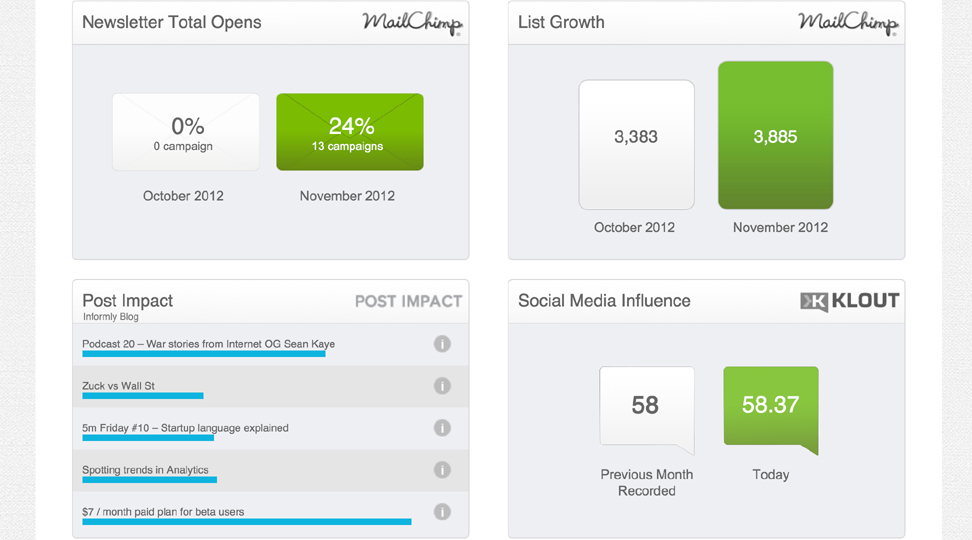
The shiny objet du jour
Social media measurement seems to be the shiny object holding everyone’s attention this year. And all sorts of folks are weighing in with their experiences and opinions, whether based on years of experience or their first time around the block. As we all try to figure out what works, we’ll have to slog through a lot of what doesn’t.
It can be frustrating reading so many contradicting opinions and new research studies that only seem to lead to more questions. I tend to get the most frustrated when I see blog posts and articles which try to inappropriately adapt traditional business or media metrics for social media. Impressions for a newspaper are transformed to social media impressions. Readers or viewers become followers, friends and fans. Worst of all, ROI becomes return on influence or return on engagement (ROE).
Can you really compare the number of viewers of a television program to the number of people following you? Integration of social and traditional media measurement is becoming more and more important, but can we find metrics that are apples to apples?
Useful and useless metrics
The bigger problem with the first two examples, though, lies with the original metrics as much as with the faulty adaptations. With the exception of ROI, these metrics can never tell the whole story or show success on their own. Often they don’t add much value at all.
Even some of the oldest business and media metrics are not based on goals. They may be used for a wow factor or simply because it’s become a habit, but we tend to forget that our measurements should always be based on business objectives. The measurement of success should measure progress toward our idea of success.
If your business recently launched a new product or service, how would you measure success? Would you be satisfied to know that over one million people saw your advertisement on television? Would you sleep better at night knowing you have 5,000 folks that started following you on Twitter? What if you don’t see any new business?
What one thing must all goals have in common?
Whether you subscribe to the SMART or DUMB theory, all goals must be inherently measureable. Similarly, any metric or number you choose to measure should in some way show success based on your original goal. If your new product launch campaign was meant to drive awareness of your new product among your current customers, does it help to know that nearly all of them had a chance to hear about your product? Or does it matter more that 60% of them remember the product’s name and key features after the campaign ends?
It’s rarely easy to do, but as we learn how to measure social media and quantify its value, we must remember to always keep our goals in mind and use them to build measurement. Shiny new numbers should never be used unless they can be tied back to a real business goal or objective. Using our goals will always set us up for success, even if our metrics aren’t perfect.
Rebecca is a passionate UNC graduate, and a biochemist-turned-communications professional, she spends her days as a senior social media analyst at Digitas in Chicago, specialized social media monitoring and measurement best practices. She is continually excited to explore additional facets of digital measurement like traditional Web analytics, search metrics and integrated data models.









































Andrew Mckay
September 29, 2011 at 7:30 pm
'bout them Heels Rebecca 🙂
Wrongly I don't track where leads come from or worry too much about ROI etc. I tend to throw it all in the pot and sees what comes out at the end. I know the "experts" say track, use this to see what works and so on. My problems is I may meet some one socially, they then read my blog and we become Facebook buddies/Twitter.
Now do I measure the success by meeting them initially, showing them my "expertise" on the blog or keeping in regular contact on Facebook. It's all so integrated these days that I'm unsure it's possible to measure.
Rebecca Denison
September 29, 2011 at 10:59 pm
I know what you mean. I've realized lately that attribution is the biggest problem we face. If you drive sales, where do you give the credit? Maybe it was that Facebook friendship, but if they click an ad, that ad will likely get the credit. It can be a mess. Thanks for reading and getting me thinking.
And you leave my Tar Heels alone!! 😉
Andrew Mckay
September 30, 2011 at 10:50 am
You'll find me in the '83 to '84 Yackety Yackety year book:)
Rebecca Denison
September 30, 2011 at 10:53 am
Get out of town!! I'm always so glad to run into other Tar Heels. 🙂
Matthew Hardy
September 30, 2011 at 11:21 pm
Reminds me of the old John Wanamaker quote:
"Half the money I spend on advertising is wasted; the trouble is I don't know which half."
Rebecca Denison
October 1, 2011 at 7:06 pm
Isn't that always the problem?